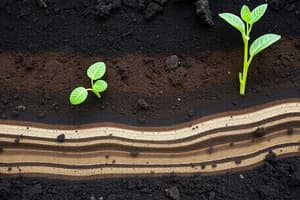Podcast
Questions and Answers
What is the color of weathered parent material in horizon B compared to the top and subsoils?
What is the color of weathered parent material in horizon B compared to the top and subsoils?
Light in color
What is the texture of horizon D?
What is the texture of horizon D?
Coarse texture
What type of soil has large particle sizes?
What type of soil has large particle sizes?
Sand
Which soil type has very good water holding capacity?
Which soil type has very good water holding capacity?
Which soil type has small pore spaces?
Which soil type has small pore spaces?
What is true about the drainage of sand?
What is true about the drainage of sand?
How does loam soil support plant growth?
How does loam soil support plant growth?
Horizon D contains very little ______.
Horizon D contains very little ______.
Flashcards are hidden until you start studying
Study Notes
Soil Horizons
- Horizon B: Weathered parent material, lighter in color compared to topsoil and subsoil.
- Horizon C: Parent/bedrock, very light in color.
- Horizon D: Parent/bedrock, very light in color, contains little organic matter, coarse texture due to partially broken down rocks, consists of unweathered rocks.
Soil Types
- Sand: Large particles, poor water holding capacity, large pore spaces, fast drainage, good aeration, heats/cools quickly, easy to cultivate, plants suffer from drought in dry seasons.
- Clay: Small particles, excellent water holding capacity, small pore spaces, very slow drainage, poor aeration, heats/cools slowly, difficult to cultivate (sticky when wet, hard when dry), plants may be waterlogged during wet seasons.
- Loam: Mixture of large and small particles, good water holding capacity, large and small pore spaces, fast drainage, good aeration, maintains a consistent temperature, fairly easy to cultivate, typically adequate water for plant growth.
Soil Texture and Structure
- Soil texture refers to the relative proportions of sand, silt, and clay particles.
- Soil structure describes how soil particles are arranged and clumped together, which affects aeration, water movement, and root growth.
Studying That Suits You
Use AI to generate personalized quizzes and flashcards to suit your learning preferences.




